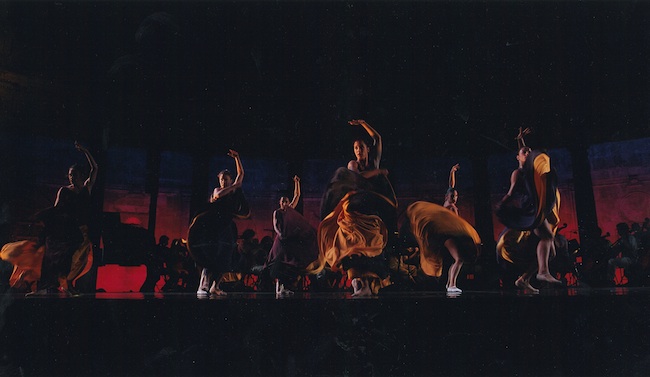Event
L’Amour Sorcier / Al Andalús
BackTours
(Festival Italica)
Patio de Tormares
Seville / Espagne
(Festival Italica)
Real Alcazar
Seville / Espagne
Institut Français
Marrakech / Maroc
Théâtre Mohammed V
Rabat / Maroc
Institut Français
Meknès / Maroc
Institut Français
Casablanca / Maroc
Institut Français
Agadir / Maroc
Le Manège
Mons / France
Centre Culturel Aragon
Tremblay / France
Le Préau
Vire / France
Ballet for 10 dancers
Originally created for the Nancy Opera in 1997
The ballet was taken up by the Compagnie Blanca Li in partnership with the Massy Opera and the Granada International Festival in 2004.
Timing : 30 mn
Choreography : Blanca Li
Music : Manuel de Falla, libretto by Gregorio Martinez Sierra
Scenography : Victor Ramos
Lights : Christine Richier
Costumes : René Zamudio
This piece is part of an evening program of neoclassical and modern ballets, inspired by Andalusia and its links with arabic culture, titled Al Andalús, which can include (according to different versions) Nana and Lila, El Amor Brujo and two new creations by Blanca Li, Canciones Populares, with music by Carmen Linares, and Silhouette, with music by Tao Gutierrez.
In its most prestigious version, all the music is interpreted live by a symphonic orchestra, a flamenco singer, a flamenco guitarist and the Gnawa Halwa from Marrakech. Titles of the pieces, year of creation : Nana (1993) Canciones Populares (2004) Silhouette (2004) El Amour Brujo (1997)
In 1997 for the 50th anniversary of Manuel de Falla’s death, Jean-Marie Blanchard commissioned the Granada born dancer and choreographer Blanca Li to direct and create the choreographic pieces for La Vie Brève and L’Amour Sorcier at the Opéra de Nancy.
Whereas her fellow countryman introduced elements of the traditional flamenco in a very modern musical piece, Blanca Li chose to keep only the spirit of the gypsy legend and translate it into a contemporary language. But she also has an intimate knowledge of both the technique and the culture of flamenco. Without using it in a direct way, she drew her inspiration from the same sources and succeeded in staging a completely renewed interpretation of this ballet, now known as a classic of the Spanish repertoire.
«It is a very personal creation, a sort of concentrate extract of my intimate relation with Andalusia and with the flamenco, the music and the dancing I grew up with. I have traveled a lot and my work draws its inspiration from a great variety of sources, from Martha Graham to the Gnawas of Marrakech, including from other art forms. But flamenco always reappears in my choreographic pieces. Its presence just seems necessary, as a mean to go back to this part of me rooted in my childhood, where lies the very origins of my passion for dancing. This adaptable program is like an illustration of the multifaceted vision flamenco has inspired me at different stages in my life. It reveals a lot about myself.» B.L.
From the very beginning of its creation, this ballet in one act composed by Manuel de Falla has had close links with some of the legendary figures of flamenco. The great dancer Pastora Imperio commissioned Falla to write her a melody. Influenced by the legends and the olds gypsy songs which Pastora Imperio’s mother taught him, Manuel de Falla started a far more ambitious project. His composition was performed for the first time in 1915 at the Lara Theater of Madrid. It was a disaster. L’Amour Sorcier only became a ballet again in 1925 at the Trianon in Paris, starring Antonia Mercé “la Argentina” , along with Vicente Escudero and George Wague. This time it was a great success. Falla wrote to la Argentina : “what you achieved with l’Amour Sorcier is so magnificent that nothing or nobody could ever make it look pale. You and l’Amour Sorcier are all one : this is a fact that everybody acknowledges.”

